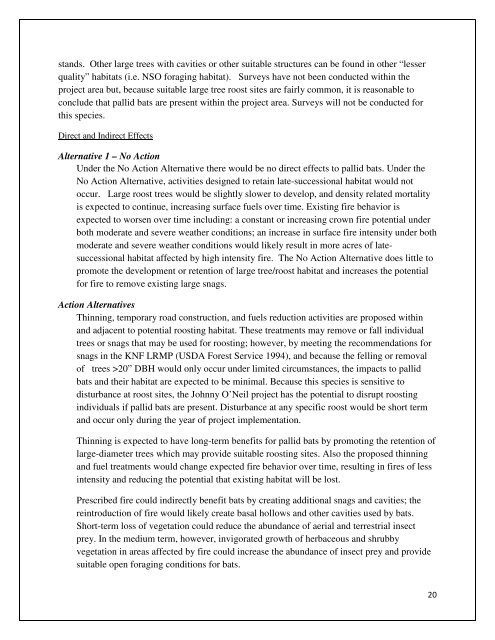Johnny O'Neil Late Successional Reserve Habitat Restoration and ...
Johnny O'Neil Late Successional Reserve Habitat Restoration and ...
Johnny O'Neil Late Successional Reserve Habitat Restoration and ...
Create successful ePaper yourself
Turn your PDF publications into a flip-book with our unique Google optimized e-Paper software.
st<strong>and</strong>s. Other large trees with cavities or other suitable structures can be found in other “lesser<br />
quality” habitats (i.e. NSO foraging habitat). Surveys have not been conducted within the<br />
project area but, because suitable large tree roost sites are fairly common, it is reasonable to<br />
conclude that pallid bats are present within the project area. Surveys will not be conducted for<br />
this species.<br />
Direct <strong>and</strong> Indirect Effects<br />
Alternative 1 – No Action<br />
Under the No Action Alternative there would be no direct effects to pallid bats. Under the<br />
No Action Alternative, activities designed to retain late-successional habitat would not<br />
occur. Large roost trees would be slightly slower to develop, <strong>and</strong> density related mortality<br />
is expected to continue, increasing surface fuels over time. Existing fire behavior is<br />
expected to worsen over time including: a constant or increasing crown fire potential under<br />
both moderate <strong>and</strong> severe weather conditions; an increase in surface fire intensity under both<br />
moderate <strong>and</strong> severe weather conditions would likely result in more acres of latesuccessional<br />
habitat affected by high intensity fire. The No Action Alternative does little to<br />
promote the development or retention of large tree/roost habitat <strong>and</strong> increases the potential<br />
for fire to remove existing large snags.<br />
Action Alternatives<br />
Thinning, temporary road construction, <strong>and</strong> fuels reduction activities are proposed within<br />
<strong>and</strong> adjacent to potential roosting habitat. These treatments may remove or fall individual<br />
trees or snags that may be used for roosting; however, by meeting the recommendations for<br />
snags in the KNF LRMP (USDA Forest Service 1994), <strong>and</strong> because the felling or removal<br />
of trees >20” DBH would only occur under limited circumstances, the impacts to pallid<br />
bats <strong>and</strong> their habitat are expected to be minimal. Because this species is sensitive to<br />
disturbance at roost sites, the <strong>Johnny</strong> O’Neil project has the potential to disrupt roosting<br />
individuals if pallid bats are present. Disturbance at any specific roost would be short term<br />
<strong>and</strong> occur only during the year of project implementation.<br />
Thinning is expected to have long-term benefits for pallid bats by promoting the retention of<br />
large-diameter trees which may provide suitable roosting sites. Also the proposed thinning<br />
<strong>and</strong> fuel treatments would change expected fire behavior over time, resulting in fires of less<br />
intensity <strong>and</strong> reducing the potential that existing habitat will be lost.<br />
Prescribed fire could indirectly benefit bats by creating additional snags <strong>and</strong> cavities; the<br />
reintroduction of fire would likely create basal hollows <strong>and</strong> other cavities used by bats.<br />
Short-term loss of vegetation could reduce the abundance of aerial <strong>and</strong> terrestrial insect<br />
prey. In the medium term, however, invigorated growth of herbaceous <strong>and</strong> shrubby<br />
vegetation in areas affected by fire could increase the abundance of insect prey <strong>and</strong> provide<br />
suitable open foraging conditions for bats.<br />
20
















